Personal Report of
The Sixth TRIZ Symposium in Japan, 2010
on Sept. 9-11, 2010, at Kanagawa Institute of Technology , Atsugi, Kanagawa, Japan
Dec. 25, 2010; Mar. 18, 2011
Personal Report of |
|
| Held by the Japan TRIZ Society, NPO, on Sept. 9-11, 2010, at Kanagawa Institute of Technology , Atsugi, Kanagawa, Japan |
|
| Part F. Usage of TRIZ in Education and in Academia | |
| Toru Nakagawa (Osaka Gakuin Univ., Japan), Dec. 25, 2010; Mar. 18, 2011 |
|
| [Posted on Dec. 30, 2010; Updated: Apr. 2, 2011] [Updated: Sept. 25, 2011] |
For going to Japanese pages, press buttons. Japanese translation of this page is not scheduled.
Editor's Note (Toru Nakagawa, Dec.25, 2010; Mar. 18, 2011)
This page is Part F of my Personal Report of Japan TRIZ Symposium 2010. Please see the Parent page
for the overall description of the Symposium and the general introduction of the Personal Report. I am thankful to the Authors for their permitting me to cite their slides here for introduction. Click here for the PDF file of this page of Personal Report.
(24 pages, 1.4 MB).
The following table shows the presentations to be included in this part. But currently only the top article is introduced. (Since my reviewing work is much delayed, I have chosen to work on selected articles first independent of the topic categories. See the parent page.) (Dec. 25, 20110)
All the four more presentations in the table are now finished. (Mar. 18, 2011)
[Note: As shown in the right-most column of the table, I have prepared individual HTML pages of several selected presentations for the purpose of wider circulation. Each presentation has English and Japanese pages containing (Extended) Abstract, presentation slides, (full paper), and Nakagawa's introduction. (Sept. 25, 2011)
]
Part F. Usage of TRIZ in Education and in Academia
Toru Nakagawa (Osaka Gakuin Univ.) [JI08, L-3] gave a Special Interest Lecture, i.e. an Invited Lecture, with the title of "Education with TRIZ: For New Perspectives". I would like to quote my Abstract here first:
TRIZ, a methodology of creative problem solving, has been promoted in Japan mainly in the field of technology and towards industrial engineers. It should be necessary and useful, however, to enhance its promotion in the field of education both in higher education and middle and primary education. For this purpose Japan TRIZ Society has recently started the "Education with TRIZ" Study Group. In the present paper I would like to overview different approaches/experiences done by people in Japan and overseas, including by myself, and make new perspectives for the future.
The first main field is the education and research of/with TRIZ in the universities and graduate schools. It is necessary not only to teach knowledge and techniques of TRIZ, but also to cultivate capabilities of creative problem solving, of comprehension of overall process of developing technologies and products, and of handling large, complex problems. The research and further development of the TRIZ methodology is also needed.
The second main field is the introduction of creative thinking way of TRIZ into secondary and primary education. In this case, it is essential to choose suitable contents and styles of teaching depending on the interest and maturity of the pupils. Attracting their interest is most important, and hence we need to choose proper topics and materials. Since classes for children have been developed and carried out in Russia etc., we would like to learn such experiences. Concerning to the education with TRIZ, it should be effective and helpful for us to go out and learn from various people working for education of creative thinking outside TRIZ.
| As the background of this lecture, I first showed the current distribution of universities and schools more or less involved in TRIZ in Japan (slide (right)). Red circles represents organizations or individuals working as JTS members, while light-blue circles those working as non-members of JTS. Larger circles mean that there are at least one full-time teacher, while smaller circles a part-time teacher or an individual. Thus full-time JTS-member teachers (i.e., big red circles) are working at Kushiro National College of Tech., Miyagi TRIZ Study Group, Waseda Univ., SANNO Inst. of Management, Tokyo Metropolitan Univ., Kanagawa Inst. of Tech., Niigata Univ., and Osaka Gakuin Univ. There are 6 big light-blue circles. |
As I wrote in the Abstract, our first target of TRIZ-based education is the universities and graduate schools (slide (below-left)). It is important for us to understand that the education of (undergraduate) students is/should be much different from the training of engineers in industries, mostly because of the difference in their background knowledge and interest. Before teaching TRIZ we need to cultivate students' background ability, and we should combine TRIZ with the specialty education in each department. As shown in the slide (below-right), there are various alternatives in designing the (TRIZ-based) courses in universities. Number of lectures (i.e., total length of time) and position in the curriculum must be officially decided in the department; this means that a teacher who wants to introduce any TRIZ education has to build up his/her capability first and to fight with and persuade other teachers to squeeze TRIZ education into the tight curriculum. Then the teacher should choose proper style of teaching and must select and design the contents to teach.
| Before showing various examples of TRIZ education, we should think over the style of education with respect to its function. The slide (right) is taken from my TRIZ class exercise on 'Functional Analysis of Lecturing' for the purpose to think of better lecture courses. I request my students to draw the functional relationship of the system of lecturing. The top diagram is the usual primitive answer by the students. Then I request them to redraw it in the manner recommended by USIT. When requested to put the most important object at the top, some students put 'teacher' there (diagram below-left). After some discussion, students agree to put 'students' at the top, and then finally divide the 'students' into 'myself' and 'other students' (diagram below-right). |
The various 'materials' for teaching may be listed up. And they may be represented by 'Information of the contents of the lecture', where the personal talk by the teacher may be an important component. The Functional Diagram is thus obtained as shown in the slide (below-left). Then I pose the students a question 'Something WRONG in this diagram?'. Now the students understand: In the diagram (below-left) the most important function (or activity) is missing; i.e. the activity of learning and understanding for myself. The function of learning and understanding is acted mainly by 'myself' and on 'myself'. -- This is a very clear and convincing presentation of the mechanism of lecturing (or education) written in the form of Functional Diagram in TRIZ (or USIT).
| In my TRIZ class, I go ahead to show the slide (right). Since the activity of 'Learn and Understand' is mostly mental, we should better show the relationships among actual activities, intellectual activities, and mental activities. When we, as a student, are attending at a lecture, we do look (or watch), listen, and read as in intellectual activities, and we obtain new information. However, for understanding the new information properly, we need to have some background knowledge (or understanding as the basis). By combining with such relevant understanding, the new information can be turned into new understanding. (For this process, we need to ask, inquire, survey, and think and work to understand.) For making the 'new understanding 'into deeper and solid 'new perception', intellectual activities as shown in the slide may be necessary and useful. To promote all these mental activities, we, as a learner, need interest, motivation, passion, mind, wish, etc. and also a lot of efforts. Thus the teacher has to attract and encourage the students to have these mental attitude. This scheme gives us a good guide to design our courses of TRIZ education. |
With variations in education styles and contents in mind, I would like to introduce you several case studies published so far. The slide (right) shows Example A1 which is taken from the TETRIS Project of EU. This project aims at establishing a TRIZ course at high schools, universities, and industries by the collaboration of more than 10 organizations distributed among several EU countries. The project made a textbook "TETRIS TRIZ Handbook", which is a nice compilation of Body of Knowledge of Classical TRIZ, and is distributing it in five language versions in CD-R without charge. This may be regarded as a material for "Lecture to teach TRIZ". --- But I rather think it necessary for us to adapt our education more to students' background knowledge and interests. |
Example A2 (two slides (below)) is Nakagawa's lecture class at Osaka Gakuin Univ. It is an optional, non-mandatory course for the 2nd year (2nd term) students in Faculty of Informatics. The theme is "Methodologies of Creative Problem Solving". The topics of 15 lectures (90 minutes each) are shown in the two slides. Lectures start with easy introduction of examples and background knowledge, and go on to the methods for analyzing the problems and generating solutions, and wrap up with the explanation of the whole processes of USIT (i.e., a TRIZ-based process easy to learn and apply) and of TRIZ. The lecture has the skeleton of problem solving process, and contains concepts and methods taken from TRIZ, USIT, and some other relevant methods. In short, this is a lecture course on Creative Problem Solving having TRIZ/USIT in its core part, but not a course of teaching (Classical) TRIZ. This is my choice of education at the university level.
In the following two slides (below), four examples are shown on TRIZ-related courses carried out in Japanese universities. The "Creative Design Exercise Class" (Ex. A3) has been carried out intensively in the Univ. of Tokyo by Professor Masayuki Nakao et al. [*** They published a book on their class in 2008, and I read it recently after the Symposium. I should have introduced their class in more detail, I regret.] They use the Function-Behavior-Structure Model as the basis of their design methodology, and teach their own way of solution generation methods which are closely related to Axiomatic Design and partly incorporating TRIZ. [*** Unfortunately, however, Professor Nakao has been a critique against TRIZ since his experiences of disappointment of Classical TRIZ and TRIZ software tools around 1997-1999.] They have taught about 130 students every year in Mechanical Engineering of the prestigious University of Tokyo. Ex. A6 (slide (below-right)) is also an interesting case. In the students' Formula SAE Project, a student used TRIZ effectively for improving the design of air intake pipe of the combustion engine. He generated a nice idea by using TRIZ Contradiction Matrix. Prof. Masao Ishihama says that the student could generated a useful idea partly because of his experiences in machining and capability of CAE software as the background. It should be noticed that almost all the teachers in these examples (A2 through A6) have experiences of working in industries before becoming university teachers. [e.g., Nakagawa worked for Fujitsu for 18 years as a researcher and a managing staff.]
| In Japanese universities, undergraduate thesis works in TRIZ are rather rare. Nakagawa's Seminar Class may be such an exceptional case, because TRIZ is the main topic of the lab. See slide (right). The Seminar Class has much longer time (90 minutes class every week, for 2 years) of education of/with TRIZ. Thus if the students already passed the lecture class (as shown in Example A2), they can be trained well in problem solving. [In reality, some of the students came to my seminar class without passing my lecture class in the 2nd year, thus causing difficulties.] Learning case studies and doing group exercises of problem solving are done in the 3rd year. Then in the 4th year students do their thesis work. Even though they work on individual problems, we do group discussions on the problems by turn. Case studies of solving familiar problems have been accumulated as shown in the slide (right). It is important for the teachers to brush up students' theses later into good case studies which are useful for many people to learn. |
At the level of graduate schools, we should expect two type of TRIZ education/research. Ex. A8 (slide (below-left)) suggests to apply TRIZ to problem solving in Master or PhD thesis work in various specialty fields. This must be the main target of introducing TRIZ into academia, just like into industries. If research leaders are familiar with TRIZ, there must be much opportunities of applying TRIZ to research work of graduate students. Ex. A9 (side (below-right)) shows the cases of research and development the TRIZ methodology. There are several research centers of TRIZ in the West, but not so strong yet. INSA Strasbourg (France) is the only one Graduate Course specialized in TRIZ in the Western countries at moment.
| Slide (right) shows a recent case of Nakagawa's Seminar Class for 2nd year students (in the first semester), which may be a model class for younger students, down to 10 years old. In the Seminar Class, the teacher gives no lecture but facilitates the group exercise. The task is to survey as wide variety of 'Writing Instruments' as possible. The students are encouraged to think of the basic mechanisms/principles of writing, to classify the writing instruments in a hierarchical way with respect to the writing mechanisms. Then they further go head to think of various usages of writing instruments, to make a hierarchical classification of the usage, and evaluate various use of mechanisms with respect to the needs of use. All the work is done without using TRIZ terms/tools, but the students gradually understand that the writing instruments have been developed in various ways so as to fulfil different needs of writing/drawing. Thus the students begin to understand the basic TRIZ concepts of systems, system analysis, evolution of systems, etc. |
| The second target of TRIZ-based education is the primary and secondary education. The slide (right) shows the basic points we need to consider. In case of children and high school pupils, it is important to attract their interest and to adapt the teaching contents and methods to their interests and maturity. The scheme shown in the slide is a simplified version of the mental activities of learning (shown in a previous slide). We realize that Japanese TRIZ community is quite weak in the experiences of education in this aspects and that we should learn a lot from Russian/Belarussian TRIZ communities and from people working in education in Japan (and other countries). |
Example B1 (slide (below-left)) shows TRIZ-based creativity education for children. Such education has been developed and carried out actively in Russia, Belarus, etc. Nikolai Khomenko has been the leader of the Jonathan Livingston Project. When I made a research trip to Russia and Belarus in 1999, I met several researchers/teachers in such activities. Natalia Rubina gave me a full set of her hand-made teaching materials of her CID Course for Children. It is a class of one hour every week for the children from 1st to 3rd year at an elementary school. The set contains 6 Workbooks for children and 6 Guidebooks for teachers. The whole set was translated from Russian into English and was posted in my Web site "TRIZ Home Page in Japan" in 2001-2002
. Though it is difficult for us to think what concepts/methods in TRIZ and how we can/should introduce to children, these materials give us a vivid image of the class. [*** The meterials were published in chapter by chapter in HTML. Maybe I should combine them into 12 PDF files for easier printing.] Ex. B2 (slide (below-right)) describes a trial of creativity education for children of age 10-12. Harumi Ichikawa made a series of half-day workshops on "Equivalent Transformation (ET)" method. The ET method was developed by her father, Prof. Kikuya Ichikawa, since 1944 and is one of the most well-known Japanese creativity methods often used in the era of 1960s to 1980s. ET has a deep insight in the understanding and application of the Four-box Scheme (of using Generalized problem and Generalized solution), and hence is akin to TRIZ (actually there are several TRIZ leaders in Japan who were/are ET practitioners). The ET workshop experience is encouraging for us to start TRIZ workshops for children.
| Slide (right) shows a unique work done by Father and Son(s). Katsuya Miyanishi is an engineer at an IT company. His elder son, Taichiro, was a 12-year boy at a junior high school in Kanazawa city when he did his summer homework with the help by his father. Taichiro wanted to understand "Why water striders can stand and slide on the water". Father guided Son to consider various ways for water striders to stand and slide on the water surface, and to build toy models. The work was presented in Japan TRIZ Symposium 2008, as shown in the slide. The conclusion by Miyanishi was: "Curiosity, inquiring mind, Try to think! Make TRIZ familiar for children and teens." In Japan TRIZ Symposium 2010, Miyanishi family presented their second work done by their second boy Kai. These works suggest us the possibility of off-class/club activities at schools or at private organizations. |
On the basis of these pioneering experiences, some discussions are summarized in the following 2 slides (below). We believe that we will be able to start (TRIZ-based) creativity education for elementary school children to high school students if we obtain some chances. In such cases we should not try to teach (TRIZ) terms and tools, but we should try to attract their interest and to use various ways of thinking not limited to TRIZ. Approaches of using mostly observations, surveys, discussions, exercises, projects, etc. may be useful. As suggested in the slide (below-right), we should better cooperate with various people and organizations who are preceding in the education. The TRIZ community in Japan has already accumulated capability of start such trials by obtaining various chances, I believe.
The original presentation slides of this Special Interest Lecture are already posted in the Official Web site of Japan TRIZ Society

. In this Web site "TRIZ Home Page in Japan", I have posted a new HTML page of this presentation, containing the presentation slides as well

(Dec. 30, 2010).
Kai Miyanishi (2nd Grader, Kenroku Junior High School, Kanazawa/Son), Katsuya Miyanishi (- /Father) [J03, O-7] gave an interesting Oral presentation with the title of "Let's think in Little People’s and Person's Worlds! – A Summer Homework by Son and Father with TRIZ (2nd Time)". This is the second report of 'Summer Home Work by Son and Father with TRIZ' by the Miyanishi Family living in Kanazawa. Their first report was given by Taichiro and Father on 'Why Water Striders can stand and slide on the Water?' at Japan TRIZ Symposium 2008
, and it obtained the Award by the participants voting. The second report was made here by the younger son, Kai, who was a first grader, at the time of his homework, of a junior high school in Kanazawa. Katsuya, Father, guided his son with a unique approach based on TRIZ in a flexible manner. Let's read the Authors' Abstract first:
”One day, a screw that stuck to a magnet was magnetized. Why? Can I make a permanent magnet?”
The youngest son, who had seen the eldest son's research on water strider, also wanted to try TRIZ. We will report our process of the 2nd research worked together especially with the guidance of TRIZ-thinking by father. The purpose of the present study is obtaining of deep understanding of the principle and a certain experimental methodology. It is achieved by analyzing a technical problem "Magnetization of Metal" in detail by obtaining the hint from the experience of daily life, and producing the experimental methodology. Moreover, we challenged the idea-making of an original merchandise this time.As special mention, we also used some techniques this time not used in the research of the water strider. Conception method by "SLP (Smart Little People) and personification", Analysis method by "T1:T2:T3 (Analysis at time-domain)", "Attribute Listing" and "Substance-Field Analysis", et al. were used this time. We recognized that the hint to solutions for technical problem existed in usual life and our experience. And, when creatively acting with the child, we strongly appeal that the following matters are important. 1: Enjoy it together, not teaching. 2: Using methods isn't the purpose. 3: Moderate "Volume" and "Speed" 4: Continue the motivation of "Curiosity and happiness" by "Praise and Admitting".
The slide (below-left) shows the beginning of their work. Kai wanted to do his summer homework with his father, just like his elder brother Taichiro had done 2 years before. Kai brought in the topic, saying "I saw that after attaching a screw to a magnet for a long time, the screw obtained the power of magnet to attract other screws. I want to learn how the screw is made into a magnet." And Father thought the topic interesting, and said "Let's learn about it together." Thus the purpose of the homework was set, as shown in the slide (below-right). "What is necessary to make a screw into a magnet? Let's guess the conditions and carry out experiments for confirmation."
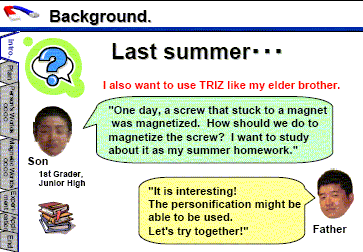

Father of course knew the physical micro-structure of magnet and the mechanism of magnetization, but he wanted to make the phenomenon of magnetization understandable for a boy of 12 years without using the concepts in physics. [*** This is the point very unique in this work guided by Katsuya Miyanishi.] The slide (right) explains the basic approach. The magnetization phenomenon in physics is paraphrased (in an abstract world) into the phenomena of human relations for understanding the meaning (even for a child). Thus they consulted a dictionary about the word of Magnetization, and found "It is a phenomenon that a material becomes to hold magnetism when a magnetic field is applied to the material from outside." In a word, "it occurs by the influence from outside." At this level of abstraction, children can think of various cases where something similar occurs as the results of influence from outside. The world of human relationships is easier for them to think of such effects of influences. |
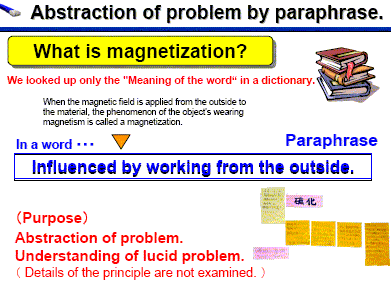 |
The slide (below-left) shows the overall structure of their approach. In the first stage (T1) they think of various cases of 'becoming similar by the influence from outside' in the world of human relationships. This stage is explained in more detail in the slide (below-right). The technical (or physical) problem is abstracted into the problem (or event) in the world of human relationships, where either ordinary people or imaginary Smart Little People are observed. In such an abstract world, the Authors try to think of various ways (i.e., solutions) to enhance the influence and also to reduce/prevent the influence. Then they return to the real world of making magnets, and try to extract the conditions for doing experiments for verification. They did the experiments in the second stage (T2, in the slide (below-left)), and tried to apply their ideas in the third stage (T3).
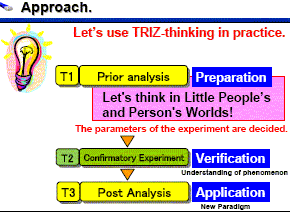
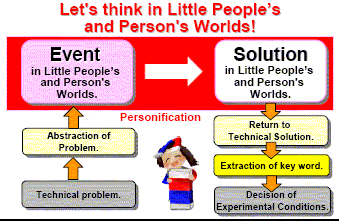
In the slide (right), the Authors thought of various scenes where a person (or an SLP) can give influences on others to make them become similar (or behave similarly). Among the 9 scenes illustrated in the slide, they have selected the following 4 scenes: (1) Chumming up with friends, (2) Influence of timidity (i.e.,when one is afraid of something, others also become afraid of it.), (3) Feel cold in the shower of water, (4) Infection of influenza (catching cold).
|
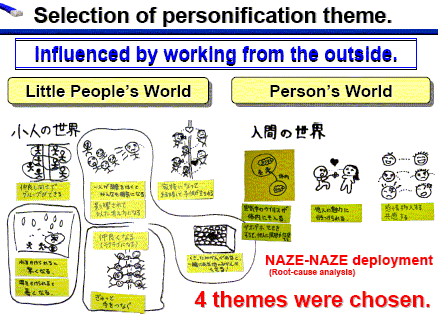 |
Then the Authors tried to imagine the scenes more vividly in the world of human behaviors. The slide (right) handles with the first case of making good friends. Various human behaviors are illustrated in slips and are classified into three timings; i.e. Past (T1, before chumming), Present (T2, at the time of chumming), and Future (T3, after chumming). Then they thought of various means to increase/decrease the degree; i.e. to become friends more/less smoothly. Each idea of means is written in a slip of paper by using keywords and an illustration.
|
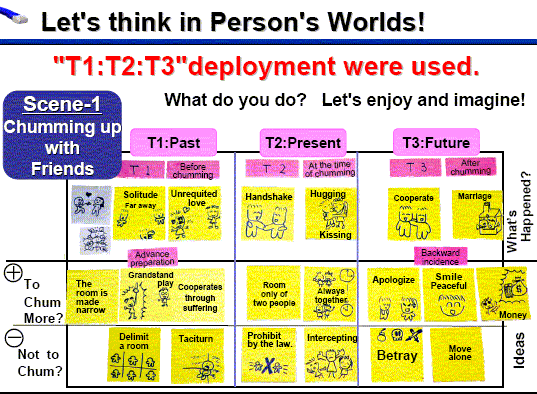 |
In the same framework other three scenes were also considered, as shown in the slide (right).
|
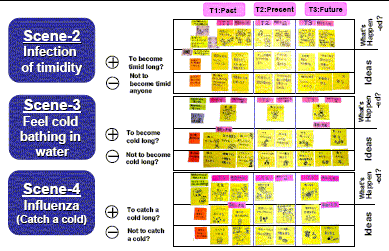 |
The means imagined in the four different scenes were collected together, as shown in the slide (right). The upper part shows the means (or solution ideas) to increase the degree of smooth influencing, even though the contents of the influence are different in the four scenes. For example, at the preparatory stage (T1), there are various ideas, e.g. 'The room is made small' (for becoming good friends), 'Gather timid fellows' (for making them more timid), 'Become naked before the shower' (for feeling cold in the shower), 'Visit disease zone' (for being infected with influenza), etc. At the bottom part, ideas for decreasing the influences are collected.
|
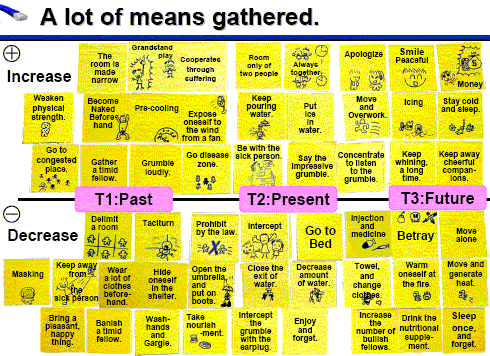 |
At the next stage, returning to the physical world of magnets, the ideas which were expressed in the world of human behavior were interpreted in the words of matters. For example, 'Always together' (for chumming) is interpreted as 'Joint them for a long time' (for magnetizing); 'Grumble loudly' (for influencing timidity) is 'Make use of stronger magnet' (for magnetizing), 'Pre-cooling' (for feeling cold in shower) is 'Adjust the temperature beforehand' (for magnetizing), etc. Then all the ideas expressed by the keywords in the world of magnet were classified by using the Affinity Diagram Method (Slide (bellow-right)). The group names in the Affinity Diagram are interpreted as (or related to) the experimental parameters, e.g., location, distance, temperature, obstacles, etc.

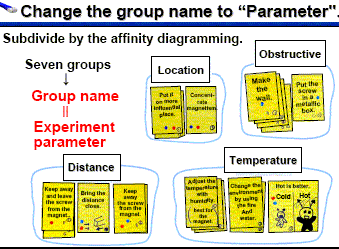
Then the Authors designed physical experiments for examining/confirming their various ideas derived so far by the analogical thinking in the human behavior. Slide (below) summarizes their experiments. They chose to vary the following factors in the magnetization process: Time length (3 days / 1 week), Strength of the magnet (600 / 2000 Gauss), Temperature (30 / -18 C), Obstacle (with / without an iron board). And then they tested how strong the magnetized screw could attract/hold up small iron objects like a clip or a stapler needle. The photos show the actual way of their experiments. In the photo (bottom-left), each screw is placed up right on a small magnetic disk. The results of the experiments are shown in the table. The Authors say it was hard to find clear difference in the results. But the results hand-written in the slide say: (1) Attract the more by magnetizing with the stronger magnet. (2) Lower surrounding temperature is better. (3) Stronger with the iron plate in the middle than without it.
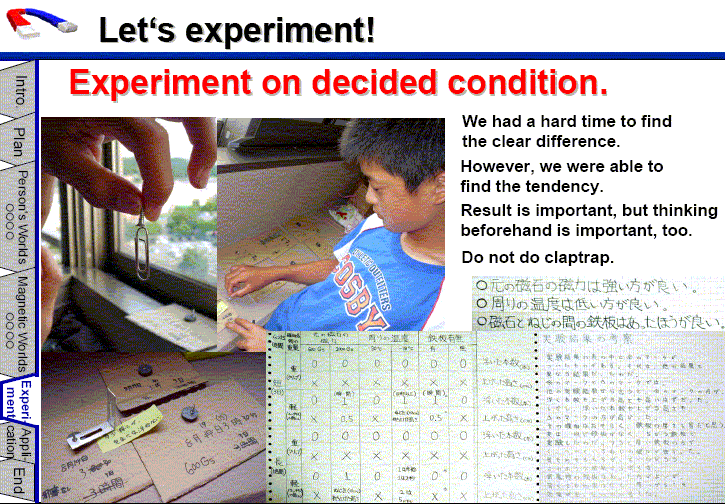
As an application of the findings obtained during the study, a favorite idea was written down in the form of a patent description (slide(right)). Kai's invention is a magnetized eraser (i.e. an eraser containing magnetized iron powder) which may be good in erasing and have the merit that the waste debris of the eraser will gather together by themselves. [*** It is nice to write down any favorite idea in this form. This is a charming idea by a boy.] |
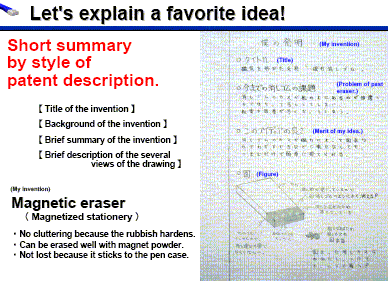 |
In the slide (below-left) the Authors summarize their study. Unique point of the Authors' approach is trying to understand the technical problem or physical phenomenon more deeply by using the hints in a field quite different but familiar for children, i.e. the field of human relationships and daily life. Comments by the family members are shown in the slide (below-right). Kai, the Son, feels that a variety of methods he used here will be useful later in his way of thinking and that the present work was too hard for him. The Authors reported that when Kai showed the homework report to his teacher in the beginning of September the teacher could not understand the work and was not interested in it at all. Kai was disappointed much with the fact. Katsuya, Father, reflected on the hardness of the work, in the aspects of its understandability, volume, and speed. He wants the teacher to be more curious to listen to an unfamiliar method like this.
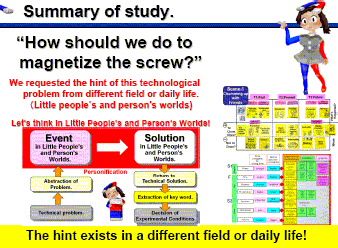
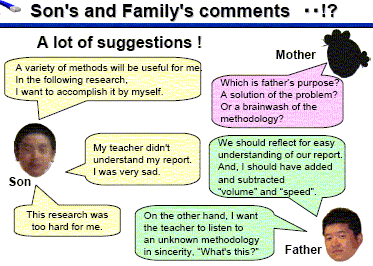
In the last slide (right) the Author, Katsuya, summarizes the lessons learnt from the present activity with his boy. [*** All these points are very interesting and important, I feel.] He says at the top "Let's use it more flexibly, freely, and actively". [*** He uses various methods of TRIZ but in a unique way after reorganizing for the present case.] This point is directly connected to the point (2) "Using the method isn't the purpose." Most important point is (1) "Enjoy it together, not teaching." Thus we should try to (4) "Continue the motivation of Curiosity and Happiness" by (5) "Praising and Admitting" and by (3) "Moderating the Volume and Speed". [*** All these are important lessons we should keep in mind in various activities with children.] At the bottom of the slide the Author writes "Personification and SLP are very useful." [*** This is the most unique point of this presentation. Instead of trying to 'teach' the physical phenomenon in terms of physics, the Author tried to enjoy understanding it in the words of daily life and human behavior, which children can imagine and understand well. ] |
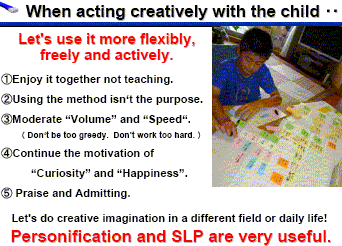 |
[*** This presentation is not an orthodox way of TRIZ application. But we can learn a lot from this. This presentation obtained the Award of "Best Presentation for Me" by the participants voting of the Symposium. Congratulations Kai and Miyanishi Family to your wonderful homework report! ]
Seiji Watanabe and Tetsuya Narisawa (Kushiro National College of Technology) [J22, O-9] gave an Oral presentation on "Present State and Problems in Creative Education at Technical College". The Authors' Abstract is quoted here first:
There are 51 national, 3 public and 1 private technical colleges in Japan. Unlike the education systems in the universities, the technical colleges admit junior high school graduates, think a great deal of experiments and actual practices, and conduct consistent professional 5-year education in order to nurture experts who can respond to the progress of science and technology needed in society. After 5 years of a regular course, advanced 2-year engineering courses are set up. Besides the acquisition of scientific and technical knowledge, which has been cultivated to date, the cultivation of creative skills to build new things and engineering design abilities in fusion/composite regions are included as the ability expected to students by higher education industrial institutions. Cases and problems will be reported on creative education in regular and major courses at Kushiro National College of Technology.
To understand the position of this presentation, you will need some detailed knowledge about the school system in Japan. The figure (right) is taken from the Web site of Institute of National Colleges of Technology. 'Colleges of Technology' is usually called KOSEN in short in Japanese. In the figure KOSEN is shown in blue rectangle. It accepts the entrance of graduates of junior high schools and gives 5 years of education specialized in engineering. Its history is shown in the slide (below-left). KOSEN was established by the strong demands from industries for technicians/engineers. The map shows the locations of KOSENs. Kushiro KOSEN is the one shown at the north-east end in this map. The features of the education in KOSEN are shown in the slide (below-right), resulting in good reputations especially in manufacturing industries. However, its education also has some problems as shown in the slide (below-right). |
|
Hence the focus of this presentation is the development of Creativity Education, which has not been well practiced so far. The Authors trials are shown in the slide (below-left). In the Regular Course (which starts at the age of 15), the Authors developed 'Creative Engineering' class for 2nd yr students. The themes in the Mechanical Engineering Department are shown in the slide (below-right); they look attractive.
In the Advanced Course, Kushiro KOSEN has started 'Special Experiment' class in 2005. For this 15 week class, the Authors set the theme of 'Building a 3D-CAD model of Leonardo da Vinci's drawings' (slide (below-left). They write the reasons for selecting this theme in the slide. The process is guided in four steps and is illustrated in the case of 'Auto-feed hydraulic saw' as shown in the subsequent four slides (below). (1) Explore to read the draft and take notes of observations. (2) Analysis, for considering the detailed parts and their mechanisms. (3) Integration of all the parts into a system. (4) Acceptance, or presentation. |
The Authors want to introduce some methodologies for cultivating students' creative abilities. They are studying methods like TRIZ/USIT, Root cause analysis, Brainstorming, Brain-writing, NM (Nakayama Masakazu) method, and KJ (Kawakita Jiro) method.
[*** I recall the pleasant visit to the Leonardo da Vinci Museum at the time of ETRIA TFC 2004 in Florence and watching the interest wooden models rebuilt from Leonardo's manuscripts. It must be worthy if the Authors (and their students) communicate with Dr. Romano Nan, the Director of the Museum. Modelling with 3D-CAD is a flexible and effective way of learning the ingenuity of Leonardo da Vinci.]
Kurumi Nakatani (Osaka Gakuin University, 2nd Year Student) and Toru Nakagawa (Osaka Gakuin University) [J17, P-B3] gave a Poster presentation with the title of "A Large Variety of Writing Instruments: Studying the Evolution of Technologies in Familiar Items". I will quote our Abstract first:
This paper reports the activities in Nakagawa's Seminar Class for the 2nd year students (with 10 members) in the 1st semester, i.e., from April to July, 2010. The students selected (or were assigned to) this Seminar class just after reading my syllabus with the title shown above. Without any knowledge about technology development, systems engineering, creativity techniques, nor, of course, TRIZ, the students started this class.
At first, for recognizing a variety of writing instruments, the students were requested to show their own items which they are carrying around at school and to describe the good points of their favorite items. Then a home work was assigned to visit stationery stores and home-centers and to report about as wide variety of writing instruments as possible. Then they are advised to observe various writing instruments, to consider their mechanisms/principles of writing and their merits, and further to classify them in a hierarchical manner. Then the wide range of intended use were considered to specify 'what, on which, and how (during the process and as the results)' to write/draw, and were built up into a hierarchical system. It was gradually understood by the students that with the requests of different use a variety of writing instruments have been developed, such as different in their mechanisms/principles, in shapes, in the characteristics of materials (e.g. inks), etc. This class is designed to make gradual understanding of the ways of evolution of technologies through familiar items, and understanding of important TRIZ concepts without using TRIZ terms. -- Ms Nakatani will talk about her experiences in the Poster Session.
As written in the Abstract, one of my 2nd year student, Kurumi Nakatani, made a Poster presentation of the results of our Seminar Class. The theme of the Seminar was freely chosen by the teacher and was announced to be the same with the title of this presentation. Thus it is natural that the students, just like you at moment, were initially wondering about the intentions of the Seminar (see slide (right)). I, the Teacher, gave no lectures to the students but asked various questions and requests one after another, just like a facilitator. The Poster slides were essentially the records of the class along its progress. In slide (1) (below-left), students were requested to list up different kinds of Writing Instruments as widely as possible. Then in slide (2) (below-right), they were requested to explain the mechanisms of writing with each of them. And the next task was to classify the Writing Instruments according to the mechanism. |
In several weeks (with a class every week), students gathered a large number of examples of Writing Instruments. So we decided to make a big joint report of them together. Slide (4) (right) demonstrates a part of the report. All the examples were described in the hierarchical system of classification according to the mechanism. They were also written in a tabular form.
|
Next the students were requested to think of various scenes of usages of the Writing Instruments. They were further requested to think 'For what purpose was this Writing Instrument made?'. This question urged the students think bout the relationships between the writing mechanism and the usage. They were then requested to classify the types of usages. In this classification, the students needed to find a framework of classification. With the 5W/1H thinking, important aspects were found to be What (pictures, drawings, characters), Where (on which substance), and How (during writing and as the output).
|
On the basis of these preparations, the students made an important summary table of the large variety of Writing Instruments, as shown in the slide (right). Rows of the table show the method (or basic mechanism) of writing/drawing. 'Gives a damage', 'Leaves a part of itself as a trace', 'Add a solid', 'Add a fluid', 'Add a liquid', etc. are the mechanisms. Columns show the substances on which we write/draw. Then in each cell, the method & substance pair is roughly evaluated in their effectiveness, usefulness, etc.
|
Minami Hamada (Kanagawa Institute of Technology) [J20, P-A4] gave a Poster presentation with the title of "Concept Design of a Child-Seat by TRIZ Style Problem Identification (Second Report)". The Author is a 2nd year graduate student for Master's Degree. Last year she and Professor M. Ishihama gave an attractive presentation

and obtained the 'Best Presentation for Me' Award by the participants voting. I will quote the Author's Abstract first:
Only 50% of cars carrying children on Japanese roads are equipped with child seats. Behind this low penetration number, sits insufficient performances of conventional child seats. To solve this situation, the author has been studying child seats that can swing on a spherical surface to cope with deceleration in collision and to absorb vibration while allowing children move freely during stable cruising. This concept was reported in the 5th Japan TRIZ Symposium. However, a problem was remain unsolved at that time, i.e., rocking vibration continues after a shock due to the lack of a damping mechanism. To invent a damping mechanism without any adverse effects, contradiction matrix was used first. Then, substance - field analysis was conducted. Introduction of a new "field" in a system came to the author’s mind. From here, the author searched physical principle that can act as damping but not utilized yet. Electro-magnetic induction that generates eddy current seemed to be the solution. From this, analogy was taken to find realizable mechanism in different industry field. The study is in the stage of embodiment design at this moment.
[*** The presentation has 16 Poster slides in Japanese and only 4 slides in English used in the Poster Introduction Session. Since the 4 English slides are very well organized to contain the essence of presentation, I am going to use them alone here. ]
The slide (right) introduces the Author's previous work presented last year. She wanted to improve the conventional design of child seats for vehicles, for making it more comfortable, convenient, and safe. Problems in the conventional design are written in the left side, while the new concept she proposed last year is written in the right side. The main feature of the proposed concept is the swinging motion of the child seat which is set on a spherical swivel. In case of accident, the seat makes a pendulum motion (with the help of triggering by the collision detection signal) to counter the lateral shock. Four metal balls between the lower and upper spherical bowls make the motion smooth, by rolling along the ditches. Side guards may pop-up after setting the child on the seat. The idea, however, was incomplete, the Author says. |
As you see in the slide (right), the Author recognized two main problems unsolved. The first problem is that rolling or pitching oscillation lingers for a certain time after a shock, because no damping mechanism is installed yet. Ideal Final Results for this aspect is to have suitable amount of damping of the motion. The second problem is that the seat does not follows the vehicle's orientation change because the swivel is spherical and has no mechanism of directing the seat toward the vehicles direction. The IFR for this is to keep the child seat always look forward. |
The Author carried out functional analysis, Substance-Field Analysis, Contradiction Matrix method, etc. The slide (right) shows the result of the Substance-Field analysis (in a wider sense). Functional relationships among the components of the child seat, child, car body, etc. are written. The blue arrows represent useful functions, while the red ones harmful functions. Excitation from road surface gives vibration to the car body structure, and to the upper components of the child seat. The rolling balls allow the pendulum motion of the upper swivel bowl, but have the harms of lingering the oscillation. The Author considers the Fields applicable in this part. Besides the mechanical fields of gravity and inertia force, the Author wanted to use some other field to control the unwanted effects. [*** Considering the applicable fields, instead of the triad representation, may be regarded as the essence of the Substance-Field analysis. This is the Author's understanding, and I agree with her.] |
The slide (right) shows the results of idea generation. She used the Contradiction Matrix and obtained suggestions of several Inventive Principles. She selected the Principle 'Increase dimension' and obtained the solution as shown in the slide. The IFR for this case is, in terms of the degree of freedom, 'free pitch motion, free roll motion, but no yaw motion (i.e., rotation around the vertical axis)'. In the original spherical bowl design, the curvature was constant in the pitch and roll directions. In the new improved design, the pitch curvature is chosen different from the roll curvature. In this manner the yaw motion of the child seat is suppressed. Even though not shown in the last slide, the Author also proposed to introduced a damping mechanism by using the Eddy current of moving metal seat in the magnetic field. [*** This is a nice case study of concept generation by a graduate student. Thinking process is well explained.] |
Last updated on Sept. 25, 2011 . Access point: Editor: nakagawa@ogu.ac.jp